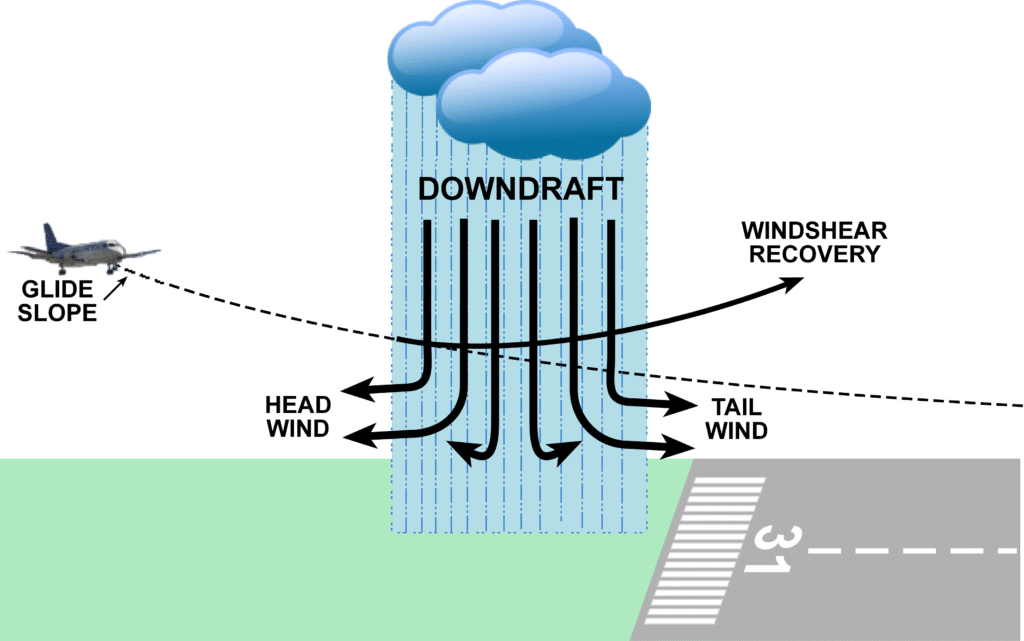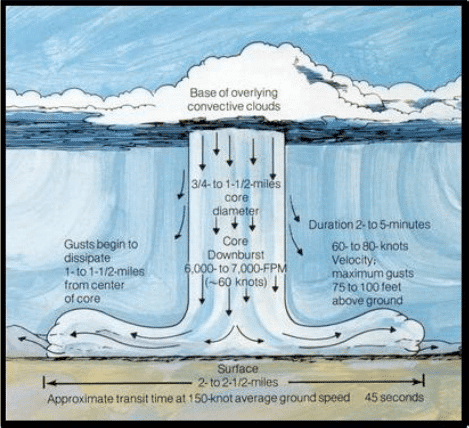Some information was taken from our Commercial Pilot Ground School Course.
Windshear occurs in all directions, but for convenience it is measured along the vertical and horizontal axis, thus becoming vertical and horizontal windshear:
- Vertical windshear: Variations of the horizontal wind component along the vertical axis, resulting in turbulence that may affect the aircraft airspeed when climbing or descending through the windshear layer. Variations of the wind componenet of 20 kt per 1000ft to 30 kt per 1000ft are typical values, but a vertical windshear may reach up to 10 kt for 100ft
- Horizontal windshear: Variation of the wind component along the horizontal axis (decreasing headwind or increasing tailwind, or a shift from a headwind to a tailwind.) Variations of wind component may reach up to 100 ft per nautical mile.
Windshear conditions usually are associated with the following weather situations: Jet streams, mountain waves, frontal surfaces, thunderstorms and convective clouds and microbursts.
Microbursts
There are two distinct threats to aviation safety which are the downburst part and the outburst part. The downburst results in strong downdrafts reaching up to 6000ft/min of vertical velocity, while the outburst results in large horizontal windshear and wind component shifts from headwind to tailwind up to 45 knots.
Influence of Windshear on Aircraft
Headwind
A headwind gust instantaneously increases the aircraft speed and thus tends to make the aircraft fly above the intended path and/ora accelerate. The downdraft affect both the aircraft angle of attack (AOA), the increases and the aircraft path since it makes the aircraft sink. The tailwind gust instantaneously decreases the aircraft speed and thus tends to make the aircraft fly below the intended path and or decelerate.
The crews do not always perceive an increase of the headwind as a risk, but such a headwind gust de-stabilizes the approach of the aircraft which will tend to fly above and/or accelerate if the pilot does not react. If the headwind shear occurs at takeoff, the resulting aircraft performance will increase. Once out of the shear, the indicated airspeed decreases thus leading to an AOA increase which might trigger stick shake activation.
Downdraft
Vertical downdrafts are usually preceded by an increase of the headwind component. If the pilot does not fully appreciate the situation, he/she will react to the headwind gust effects to regain the intended path by reducing the power and pushing on the stick. At that point, a vertical downdraft will increase the aircraft sink rate, which will bring the aircraft below the intended path.
In case of a sudden increase of the tailwind, the aircraft airspeed decreases instantaneously. The lift decreases and the aircraft tends to fly below the intended approach path. If the pilot pulls on the stick to recapture the path without adding sufficient thrust, the AOA will increase significantly and the aircraft will sink down. If sufficient thrust is set to regain the intended path, but the pilot’s reaction is then slow to reduce the thrust once back on path, the aircraft will fly above the path and/or accelerate.



